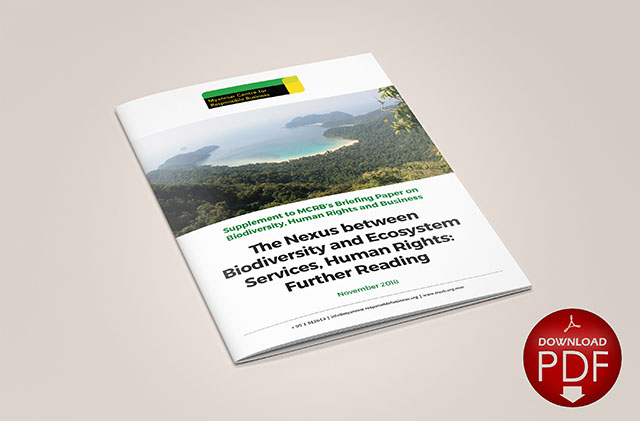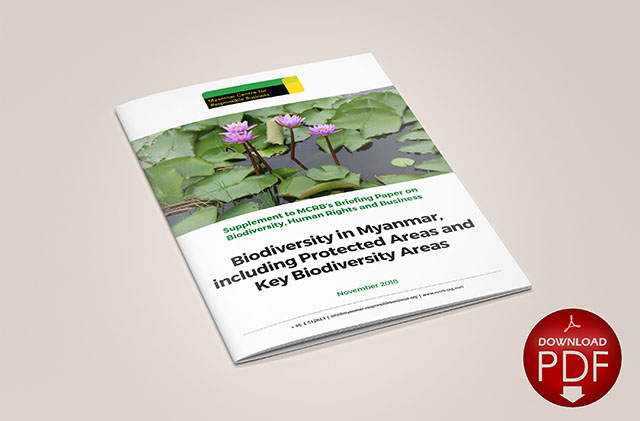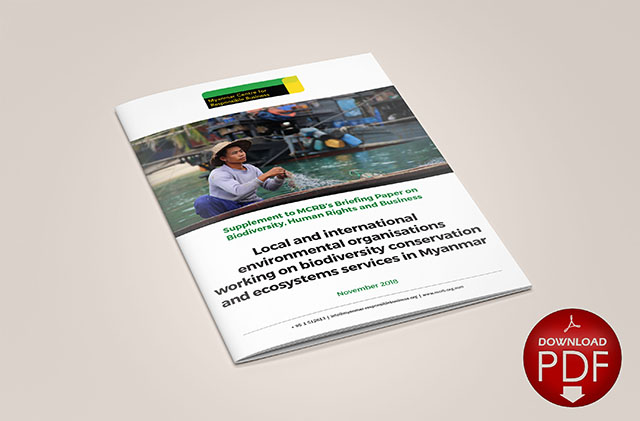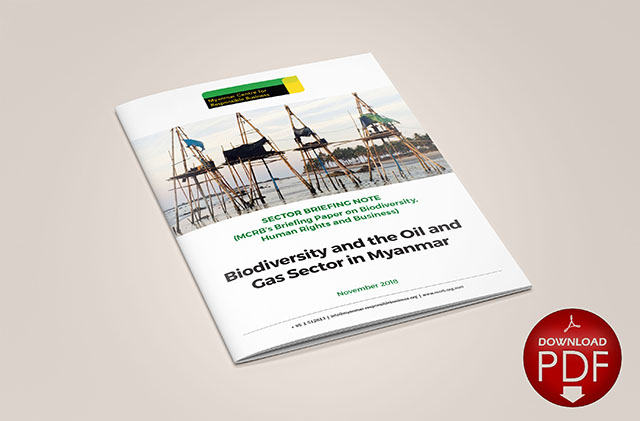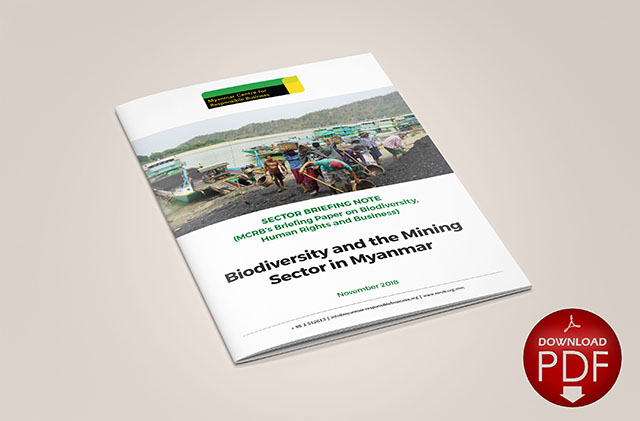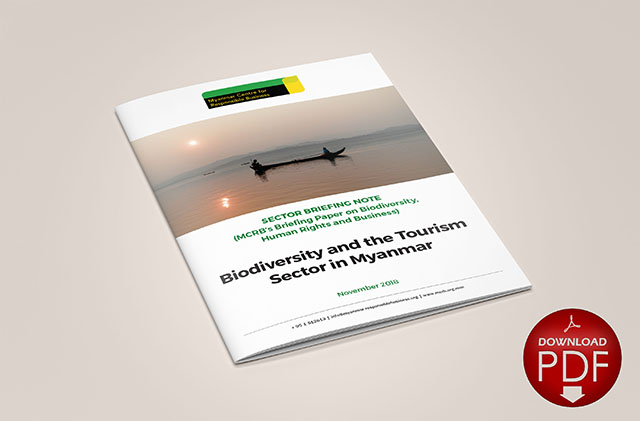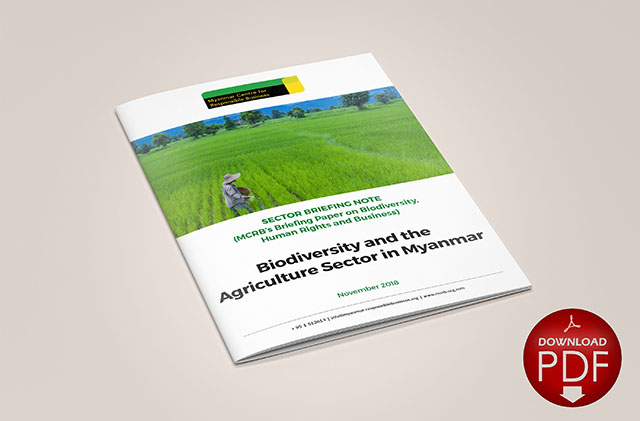Investors Need to Identify their Impacts on Myanmar’s Biodiversity and Ecosystems Early On, to Avoid Cost and Conflict Later
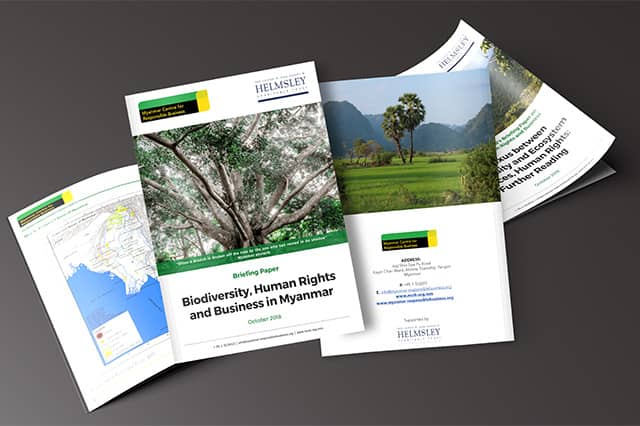
MCRB has published a set of briefing papers intended to help business, civil society and government understand how some types of investment in Myanmar can negatively impact biodiversity and thereby affect human rights, in particular the right to livelihood.
A press release is available in English and Myanmar.
Launching the paper and associated sectoral supplements on oil and gas, mining, tourism and agriculture, Vicky Bowman, MCRB Director said:
"Upfront screening to determine how a project could impact biodiversity is essential so as to avoid, wherever possible, or reduce or mitigate negative impacts. It’s also a legal requirement in Myanmar, as well as a moral obligation. Getting this wrong leads to additional cost, project delays, and conflict with other stakeholders. The Briefing Paper makes clear the strong business case for getting this right. Businesses whose operations are likely to have the biggest impact on biodiversity are likely to be those that most rely on ecosystem services, such as water and productive soils. Failure to safeguard these ecosystems will hurt the business’s bottom line. We see this in the tourism industry, for example in the environmental degradation in Inle Lake, and it is a risk in the Tanintharyi archipelago. Not only that: consumers and investors increasingly want businesses to prioritise environmental protection”.
The Briefing Paper, supported by the Leona M. and Harry B. Helmsley Charitable Trust, draws on MCRB’s research for sector-wide impact assessments in oil and gas, mining, tourism and oil palm. It was co-authored by Sally Johnson international expert on the biodiversity impacts of business, who consulted a variety of Myanmar-based government and expert stakeholders. It presents the business case for addressing biodiversity and ecosystem services, addresses compliance with biodiversity aspects of Myanmar’s environmental laws and regulations, including the recently updated 2018 Biodiversity and Conservation of Protected Areas Law and the 2015 Environmental Impact Assessment (EIA) Procedure, and offers advice on how EIA can be used by companies to improve outcomes for biodiversity and related human rights.
The Paper provides practical recommendations to companies to address biodiversity conservation in order to be – at a minimum - compliant with Myanmar environmental regulation but also offers advice for companies that are willing to take extra steps. It signposts resources to help business, including sources of biodiversity data, a major weakness of EIAs in Myanmar.
The Briefing Paper contains an Executive Summary, Recommendations to Business and five sections:
-
Section 1 explains the ‘nexus’ between business, biodiversity and human rights, and the business case for addressing biodiversity and ecosystem services
-
Section 2 provides an overview of biodiversity in Myanmar, with emphasis on the biodiversity resources that are likely to be affected by private sector activities and the major threats to them
-
Section 3 provides an overview of the policy and legal framework and institutional arrangements related to biodiversity and addresses compliance with biodiversity aspects of Myanmar’s environmental laws and regulations, including Environmental Impact Assessment (EIA)
-
Section 4 looks at how Myanmar’s EIA process can be used by companies to improve outcomes for biodiversity and related human rights
-
Section 5 provides an overview of international standards, practice and tools and application of international good practice on biodiversity protection by business, including in EIAs
The Briefing Paper is supplemented by additional material on:
-
The Nexus between Biodiversity, Ecosystem Services and Human Rights: Further Reading
-
Biodiversity in Myanmar, including Protected Areas and Key Biodiversity Areas
The paper is also accompanied by short briefing notes on biodiversity impacts of the oil and gas, mining, tourism and agriculture sectors. These sectoral briefing notes cover potential biodiversity/human rights impacts, and links to sources of more detailed guidance.
MCRB has also addressed impacts on biodiversity and environment in its sector-wide impact assessments (SWIAs) on Oil and Gas, Tourism, ICT, Mining and Oil Palm (draft, for publication in 2019).
Read also
- Building Environmental Legal Advocacy Skills for Civil Society Leaders
- Building Understanding of EIA and Responsible Business for Civil Society Groups in Southern and Eastern Shan State
- Working with Community Groups in Shan State on Responsible Business and EIA
- Join MCRB and Thant Myanmar in the Battle to Beat Plastic Pollution
- Our Biggest Challenge as Consultants is Companies Refusing to Admit Projects Could Have Negative Impacts
 English
English မြန်မာ
မြန်မာ မြန်မာ (unicode)
မြန်မာ (unicode)



